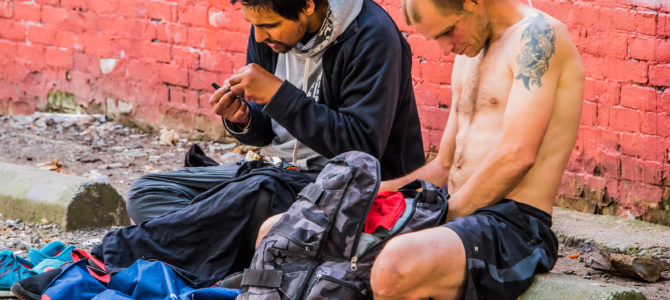
A year after the United States registered the deadliest number of drug overdoses on record, a Philadelphia nonprofit is urging the Supreme Court to allow people to freely inject themselves with drugs at “harm reduction” centers.
After Philadelphia officials expressed support for the idea of such a center, where drug addicts could ostensibly continue using with the benefit of onsite medical attention, the nonprofit group Safehouse formed in 2018. But in February 2019, U.S. Attorney for the Eastern District of Pennsylvania William McSwain filed a lawsuit asking federal judges to rule that supervised consumption sites like the one Safehouse was planning were illegal per the “crack house” statute of the Controlled Substances Act, which criminalized running a facility for drug use.
After a district court ruled against McSwain, who was appointed by President Donald Trump, an appeals court ruled 2-1 in his favor in January 2021.
Safehouse is not giving in yet, however. The group asked the Supreme Court to review its decision last month. “People are in a bit of a waiting and watching game, to see whether the [Biden] administration is going to criminalize [supervised consumption sites],” said Miriam Krinsky, executive director of the group that led the brief told the Associated Press.
Last Friday, dozens of former police officers and prosecutors filed an amicus brief claiming the “crack house” statute does not relate to supposed “harm reduction” initiatives. But such an argument hinges on the disproved notion that letting addicts shoot up has anything to do with “reducing harm.”
Safehouse intends to create an atmosphere in Philadelphia that lets addicts bring drugs to buildings, use them, and get medical care when needed. In addition to Safehouse, other like-minded groups like the far-left Philadelphia Overdose Prevention Network back the effort.
While the initiative has yet to be greenlit in the biggest Pennsylvania city, it is already policy elsewhere. Seattle moved to become the first American city to approve injection sites for heroin in 2017. Rhode Island authorized them in July and the state’s health department now must put forth regulations surrounding the sites, some of which are taxpayer-funded.
It remains to be seen whether the Biden administration would back the movement to let people do drugs with one another on the dime of the government (or potentially, private donors who stand to profit from a large group of drug addicts needing treatment). Acting U.S. Attorney Jennifer Arbittier Williams, who succeeded McSwain, has yet to publicly comment on the contentious matter.
Groups like Safehouse that support consumption sites often rely on a July 2020 study in the New England Journal of Medicine showing no deaths in an “unsanctioned” drug facility over the course of five years. The study’s primary finding is that there were 33 non-fatal overdoses involving opioids, out of more than 10,500 injections.
The problem? Data did not indicate any “harm reduction” like what’s championed by the consumption site supporters. If the eventual goal of “harm reduction” is a decrease in the number of users, the opposite was apparent. The study actually showed an increase in the number of people who went to shoot up in five years (though that may have been partially due to increased awareness of the facility). There was not only an increase in overdoses, but also in the rate of overdoses per injections.
While Safehouse would still argue that having no in-house fatalities implies a benefit, such a conclusion neglects how these sites function. Similarly planned facilities exist in Vancouver, which as a city continues to see compounded addiction, lawlessness, and homelessness. Addicts may not die in the Canadian facilities, but they sure do once they leave.
A 2019 video investigation into facilities in Vancouver demonstrated this, quoting an injection site employee who admitted the sites do not reduce overdose deaths in the neighborhood but that overdose death rates were actually rising. As journalist Christopher Rufo articulated in City Journal discussing a specific Vancouver site, the notion of “no deaths on the premises” discounted the reality of deaths occurring “within a block” from the facility.
These sites, then, are a breeding ground for addicts to get more hooked. Safehouse’s initiative, if successful, would pave the way for more death and despair after overdoses rose to 93,000 last year amid coronavirus lockdowns across the nation.
Not only are government-sanctioned drug injection facilities illogical, they are unbecoming of a country that honors human dignity and first principles. In addition to letting people violate the law and engage in an activity that should be duly negated, not fostered, Safehouse would be communicating to kids that the door is always open.
Come in, take a hit, we will save you anyway, they seemingly offer.
After all, wouldn’t anyone be susceptible to stroll in a site and have their life turned upside down? You, me, your kids? When would the cycle of harm end?
It wouldn’t. Philadelphia saw its second-highest number of drug overdoses ever in 2020, reaching 1,214. Philadelphia’s overdose rate was four times its homicide rate in 2019.
But Safehouse thinks it will solve this mess by filling up needles and propping open the door. It’s far from naïve. It’s just evil.









